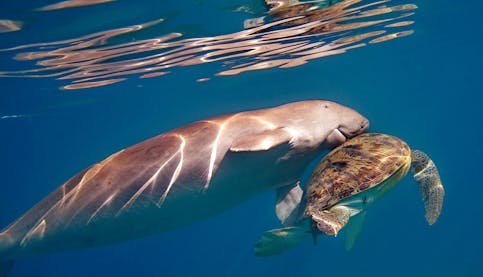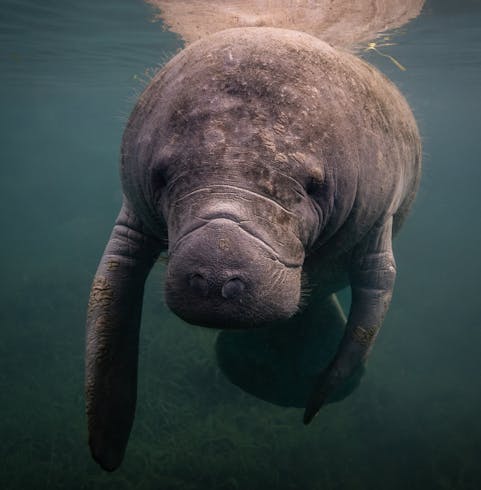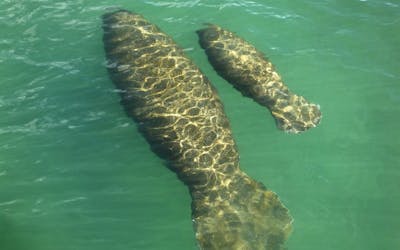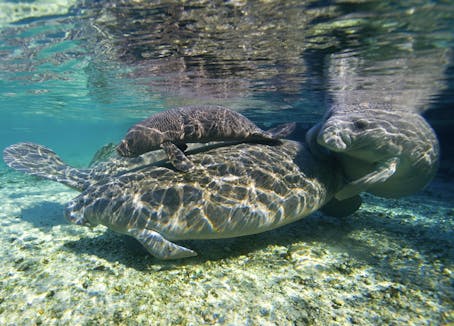Slow Speed: Manatee Zone

Living in South Florida, you see the signs everywhere and if you’re a power boater…let’s be honest, it can get a bit annoying. And you abide by the rules because you know that the number one threat to these innocent, friendly ocean dwellers are your power boat’s propellers.
Why is that? While just hanging out, Manatees can chill on the ocean floor for up to 15 minutes at a time; however, when they’re moving, Manatees need to surface for air every 3 - 5 minutes on average. If you know any freedivers, they’re likely nodding along in understanding, but we digress. Surfacing so frequently leaves Manatees prone to passing boats and while they can change direction fairly easily, they still need to surface for air and they don’t often move very quickly.
Shall we dig in a bit further?
Are Manatees Dangerous?
No. Being herbivores, they are absolutely not interested in humans as a potential food source.
Sometimes curious, these large, gentle creatures might approach you in the water to check you out. Manatees have been known to bump or rub against snorkelers which, due to their size can push you a bit…but it’s not with ill intent. And at the slow speed they move, if you ever felt threatened by one of them…we’re sure you could relocate in plenty of time.
Will Manatees Bite?


Not really. They have grinding teeth, not biting teeth due to their diet. Additionally, unlike other mammals, their teeth get worn down and fall out. Replacement teeth grow in the back of their mouths and push the older teeth out in a natural, lifelong process. Since they’re herbivores, their mouths and teeth are set up for grinding plants up to swallow…not tearing flesh from bones.
If your bare arm comes in contact with their mouth, you’ll likely feel the tickle of the little sensory bristles and hairs that grow just inside their large lips. These help them to differentiate between fish and plants.
Why are Manatees Important?
There are actually several reasons. First, Manatees help to maintain and control the growth of sea grasses and aquatic weeds. They also consume water hyacinth and other invasive species so they help keep that population under control. And without the Manatees, we wouldn’t have that important source of fertilization for those sea grasses and vegetation that supports marine ecosystems.
Also important to mention, these sweet, gentle ocean dwellers have captured the hearts of many and provide a draw for ecotourism.
What do Manatees Eat?
Mostly herbivores, the only meat Manatees ingest is usually those unlucky fish and invertebrates that get mixed in with the aquatic vegetation they feast on. Spending most of their time eating, resting, and traveling…these ocean dwellers might just be living their best life.
Did you know they can ingest up to one tenth of their body weight in one day? That’s a lot of aquatic vegetation.

How do Manatees Reproduce?

Reaching adulthood at about five years of age, the Manatee reproductive cycle is a bit long. Gestation lasts about a year and usually results in a single birth, twins are rare. Each female averages giving birth about every two to five years with the calf being dependent on mom for the first two years. The milk she produces is essential to the baby’s growth and development.
Did we mention that just after giving birth, the mother has to help the baby to the surface for its first breath of air? Yep, within a short time (roughly an hour) the calf is able to get there on its own; however, each calf is completely dependent on mom to help them get that first breath.
Where do Manatees Live?
Migratory ocean dwellers, Manatees tend to make their homes close to seagrass beds and underwater vegetation. Since they need to surface for air, we typically find Manatees in shallower waters that include canals, estuaries, saltwater bays, and coastal areas. Though in summer months they may travel as far north as Massachusetts, they tend to winter in the warmer waters and freshwater springs of southern Florida.
Don’t misunderstand, these lovely sea creatures don’t just hang out around the states, they venture down as far as the northern part of South America and can be found throughout the Caribbean and Central America. Now that’s a lifestyle worthy of a bit of envy.
When is Manatee Season in Florida?

Manatee viewing season usually starts as the weather begins to cool down, so typically around mid-October through about April or May each year. With Florida being the northernmost point of their winter habitats, the Manatees congregate here and tend to go where the water is warmer.
If you’re interested in viewing and possibly being in the water with the Manatees, check out Florida Fish and Wildlife Conservation Commission’s site that gives you up to date details including regulations, a map with locations, and information on some of those locations.
Thanks for dropping in and for abiding by those slow speed signs in the waterways.
FAQs
What are manatees and where do they live?
Manatees are large aquatic mammals, often referred to as "sea cows" due to their slow, gentle nature and herbivorous diet. Manatees are found in warm, shallow waters of coastal regions, rivers, and estuaries in the Americas, primarily in Florida, the Caribbean, West Africa, and parts of South America.
What do manatees eat?
Manatees are herbivores, and their diet consists mainly of aquatic vegetation such as seagrass, algae, and other water plants. They are known to consume large amounts of food each day to sustain their considerable size and energy needs.
Are manatees endangered?
Yes, manatees are considered endangered species. Their population is threatened primarily by habitat loss, boat collisions, pollution, and entanglement in fishing gear. Conservation efforts have been put in place to protect manatees and their habitats to prevent further decline in their numbers.
How big do manatees get?
Manatees can vary in size, but on average, they can grow to be about 10 to 12 feet (3 to 3.7 meters) in length and can weigh anywhere from 1,760 to 2,650 pounds (800 to 1,200 kilograms).
Are manatees related to seals or whales?
No, manatees are not related to seals or whales. They belong to a different order of mammals called Sirenia, which also includes the dugong. Seals and whales, on the other hand, belong to the order Cetacea. While both groups are marine mammals, they have distinct evolutionary lineages and characteristics.
